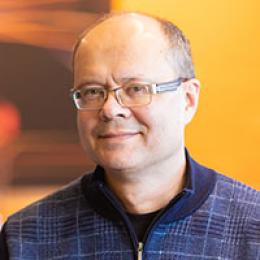Exploring natural and bio-inspired photonic nanostructures as gas sensors
Abstract
Tropical butterflies are a bright display of photonic engineering in nature. Their iridescence originates from the interference and diffraction of light within tree-like nanostructures on their scales, inspiring technological innovations in solar cells, displays, fabrics, and other areas. We are inspired by the design principles of these photonic nanostructures to boost performance of gas sensors because existing gas sensors often degrade their performance in complex environments. Thus, new sensing concepts are required to improve sensor selectivity and stability.
In this lecture, we analyze capabilities of natural photonic nanostructures as sensors for detection of different gases and the origins of these capabilities. Our acquired knowledge from studies of these natural nanostructures allows us to develop our design rules to fabricate sensing nanostructures for needed gas selectivity for numerous gas monitoring scenarios at room and high temperatures for industrial, environmental, homeland protection, medical, and other applications.
Our design rules for selective gas sensors bring a multivariable perspective for sensing, where selectivity is achieved within a single nanostructured sensing unit, rather than from an array of separate sensors. By utilizing individual nanostructured sensors rather than sensor arrays we also improved sensor stability by eliminating independent aging factors in separate sensors in their arrays. Our existing and new machine learning tools further advanced our sensor designs and performance in multi-gas detection.
These new multi-gas sensing capabilities provide an affordable technical solution for monitoring of emissions of greenhouse and other gases in urban and industrial environments. Such technical solution is mathematically not feasible using conventional single-output sensor designs. The societal impact of these results is in opening opportunities for more proactive developments of several types of multivariable gas sensors in diverse emerging monitoring applications, ranging from urban pollution and industrial safety to medical diagnostics and homeland protection.
Date and Time
Location
Hosts
Registration
-
 Add Event to Calendar
Add Event to Calendar
Loading virtual attendance info...
- 2900 Semiconductor Drive
- Texas Instruments
- Santa Clara, California
- United States 95051
- Building: Building E
- Room Number: Conference Center (ECC1)
- Click here for Map
- Contact Event Host
-
Jeronimo Segovia-Fernandez
IEEE SFBA MEMS & Sensors Chapter, Chair
- Starts 19 September 2024 05:56 PM UTC
- Ends 03 October 2024 01:30 AM UTC
- No Admission Charge
- Menu: IEEE Member, Non-IEEE Member
Speakers
Dr. Radislav A. Potyrailo
Biography:
Radislav A. Potyrailo is a Principal Scientist at GE Vernova Advanced Research Center. His passion is to bring innovative sensing systems from laboratory feasibility studies to field validations and commercialization. Dr. Potyrailo is directing programs on designs of physical transducers, sensing materials with multi-response mechanisms, data analytics, and system engineering of microanalytical instrumentation. Dr. Potyrailo has been serving as a technical lead on GE R&D programs transitioned to GE businesses or GE partners for commercialization. Examples include optical multi-parameter chemical sensor for GE Water, wireless gas sensors for GE Oil & Gas, multi-parameter oil sensor for GE Renewable Energy, and GE Ventures start-up company on radio-frequency sensors. Dr. Potyrailo has been serving as a Principal Investigator on programs funded by AFRL, ARPA-E, DARPA, DHS, DOE, DTRA, NETL, NIH, NIOSH, and TSWG. He is the initiator and a co-organizer of the First Gordon Research Conference on Combinatorial and High Throughput Materials Science and serves as an editor of the Springer book series “Integrated Analytical Systems”. He is the North America Regional Chair of International Society for Olfaction and Chemical Sensing and is the Chair of the Device Working Group of the MEMS and Sensors Industry Group. Dr. Potyrailo summarized most of his innovations in 160+ granted US Patents and publications (Google Scholar h-index 55). He is a recipient of the Prism Award by SPIE/Photonics Media (2011) and the AMA Innovation Award (2021). He is a SPIE Fellow and an IEEE Fellow, covering the whole electromagnetic spectrum of his sensors. He has been appointed as a Distinguished Lecturer of the IEEE Sensors Council for the period 2024-2026.
Agenda
6:30 – 7:00 PM Registration & Networking
7:00 – 7:45 PM Invited Talk
7:45 – 8:00 PM Questions & Answers
Hybrid presentation by Dr. Radislav A. Potyrailo, Principal Scientist at GE Research Center


